lexus LC500h 2019 Owner's Manual / LEXUS 2019 LC 500,LC 500H OWNER'S MANUAL (OM11471U)
Manufacturer: LEXUS, Model Year: 2019, Model line: LC500h, Model: Lexus LC500h 2019Pages: 432, PDF Size: 13.82 MB
Page 191 of 432
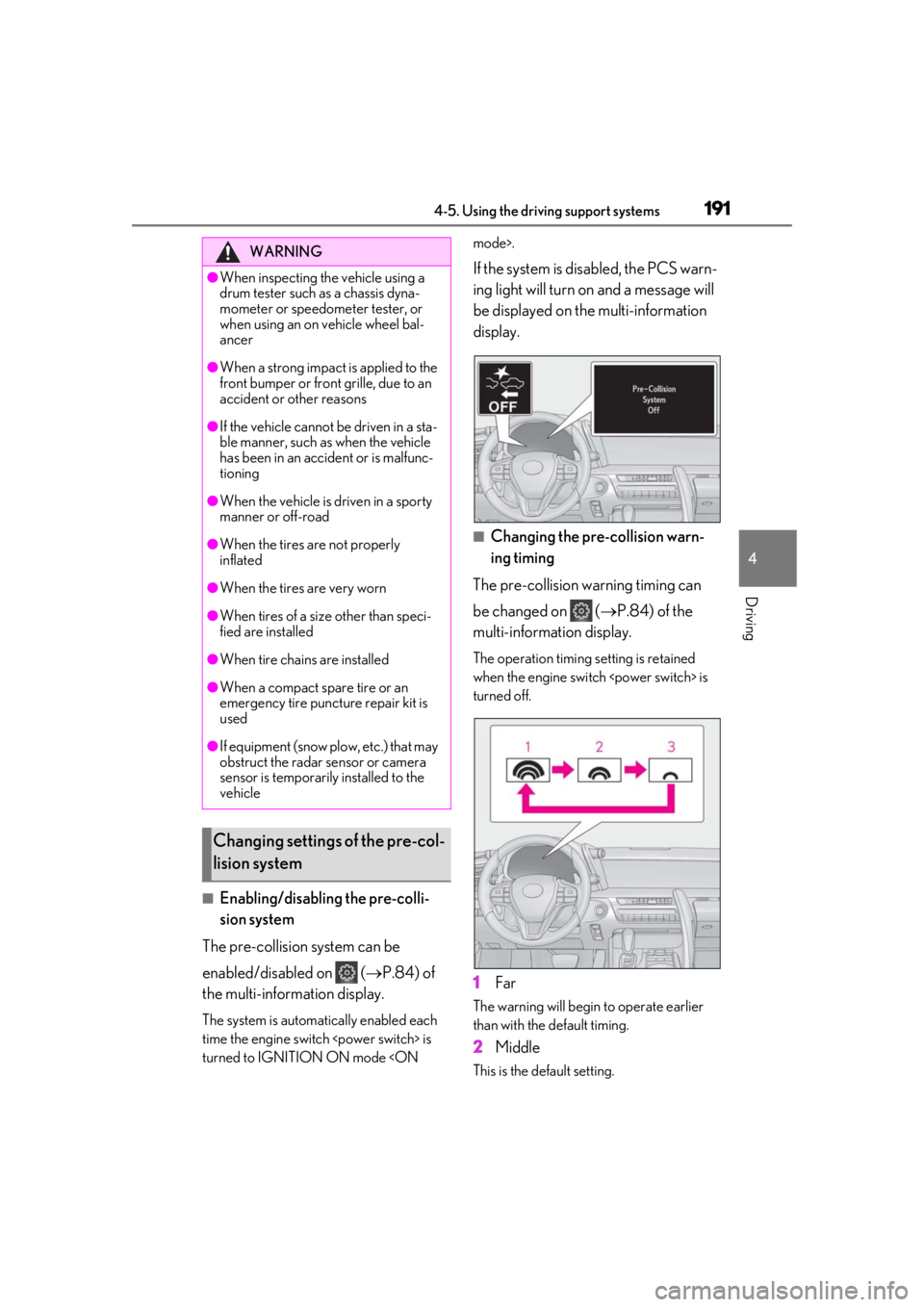
1914-5. Using the driving support systems
4
Driving
Ō¢ĀEnabling/disabling the pre-colli-
sion system
The pre-collision system can be
enabled/disabled on ( ’é«P.84) of
the multi-information display.
The system is automatically enabled each
time the engine switch
turned to IGNITION ON mode
If the system is disabled, the PCS warn-
ing light will turn on and a message will
be displayed on the multi-information
display.
Ō¢ĀChanging the pre-collision warn-
ing timing
The pre-collision warning timing can
be changed on ( ’é«P.84) of the
multi-information display.
The operation timing setting is retained
when the engine switch
turned off.
1 Far
The warning will begin to operate earlier
than with the default timing.
2Middle
This is the default setting.
WARNING
ŌŚÅWhen inspecting the vehicle using a
drum tester such as a chassis dyna-
mometer or speedometer tester, or
when using an on vehicle wheel bal-
ancer
ŌŚÅWhen a strong impact is applied to the
front bumper or front grille, due to an
accident or other reasons
ŌŚÅIf the vehicle cannot be driven in a sta-
ble manner, such as when the vehicle
has been in an accident or is malfunc-
tioning
ŌŚÅWhen the vehicle is driven in a sporty
manner or off-road
ŌŚÅWhen the tires are not properly
inflated
ŌŚÅWhen the tires are very worn
ŌŚÅWhen tires of a size other than speci-
fied are installed
ŌŚÅWhen tire chains are installed
ŌŚÅWhen a compact spare tire or an
emergency tire puncture repair kit is
used
ŌŚÅIf equipment (snow plow, etc.) that may
obstruct the radar sensor or camera
sensor is temporarily installed to the
vehicle
Changing settings of the pre-col-
lision system
Page 192 of 432
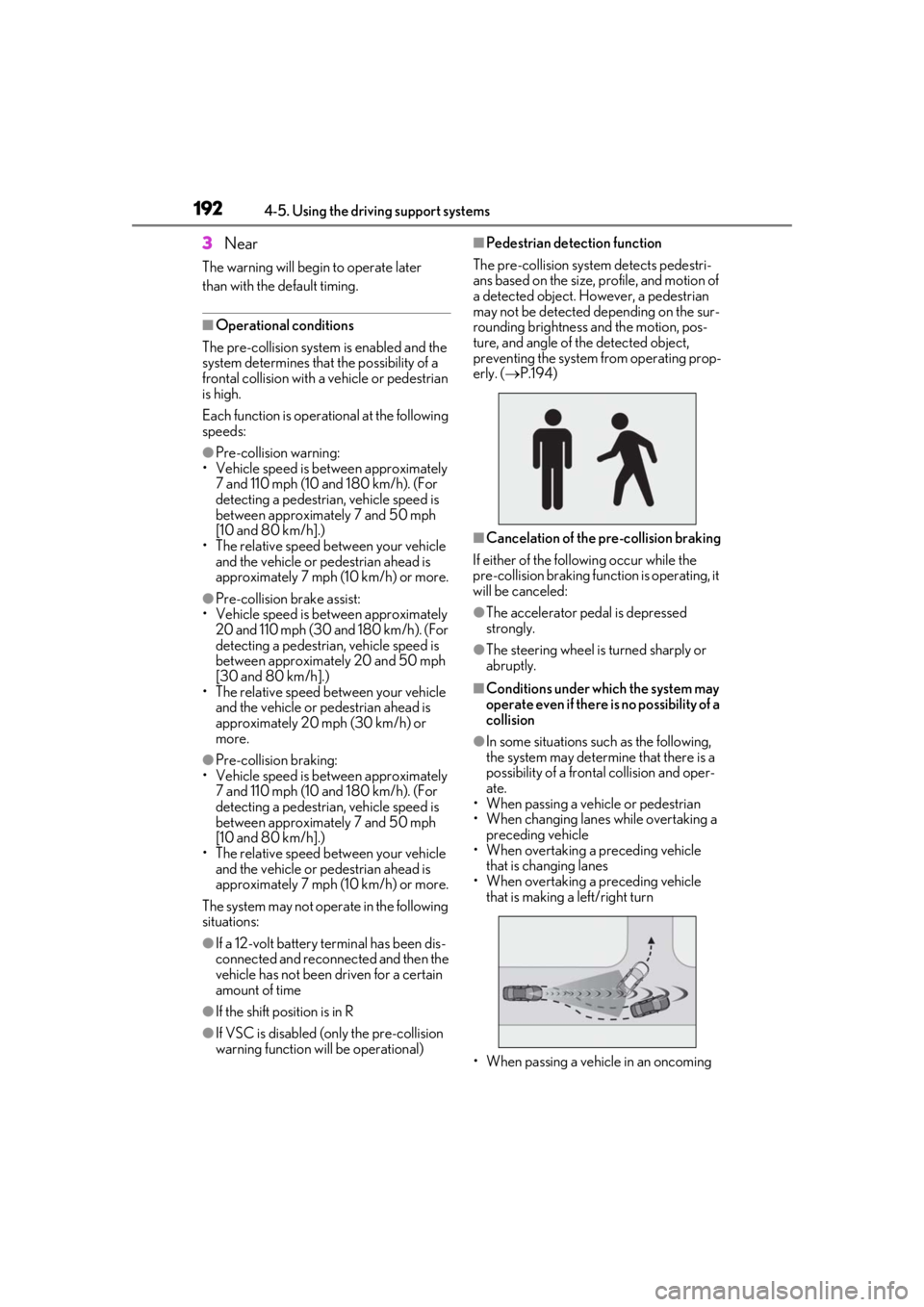
1924-5. Using the driving support systems
3Near
The warning will begin to operate later
than with the default timing.
Ō¢ĀOperational conditions
The pre-collision system is enabled and the
system determines that the possibility of a
frontal collision with a vehicle or pedestrian
is high.
Each function is operational at the following
speeds:
ŌŚÅPre-collision warning:
ŌĆó Vehicle speed is be tween approximately
7 and 110 mph (10 and 180 km/h). (For
detecting a pedestrian, vehicle speed is
between approximately 7 and 50 mph
[10 and 80 km/h].)
ŌĆó The relative speed between your vehicle and the vehicle or pedestrian ahead is
approximately 7 mph (10 km/h) or more.
ŌŚÅPre-collision brake assist:
ŌĆó Vehicle speed is be tween approximately
20 and 110 mph (30 and 180 km/h). (For
detecting a pedestrian, vehicle speed is
between approximately 20 and 50 mph
[30 and 80 km/h].)
ŌĆó The relative speed between your vehicle and the vehicle or pedestrian ahead is
approximately 20 mph (30 km/h) or
more.
ŌŚÅPre-collision braking:
ŌĆó Vehicle speed is be tween approximately
7 and 110 mph (10 and 180 km/h). (For
detecting a pedestrian, vehicle speed is
between approximately 7 and 50 mph
[10 and 80 km/h].)
ŌĆó The relative speed between your vehicle
and the vehicle or pedestrian ahead is
approximately 7 mph (10 km/h) or more.
The system may not operate in the following
situations:
ŌŚÅIf a 12-volt battery terminal has been dis-
connected and reconnected and then the
vehicle has not been driven for a certain
amount of time
ŌŚÅIf the shift position is in R
ŌŚÅIf VSC is disabled (only the pre-collision
warning function will be operational)
Ō¢ĀPedestrian detection function
The pre-collision system detects pedestri-
ans based on the size, profile, and motion of
a detected object. However, a pedestrian
may not be detected depending on the sur-
rounding brightness and the motion, pos-
ture, and angle of the detected object,
preventing the system from operating prop-
erly. ( ’é«P.194)
Ō¢ĀCancelation of the pre-collision braking
If either of the following occur while the
pre-collision braking function is operating, it
will be canceled:
ŌŚÅThe accelerator pedal is depressed
strongly.
ŌŚÅThe steering wheel is turned sharply or
abruptly.
Ō¢ĀConditions under which the system may
operate even if there is no possibility of a
collision
ŌŚÅIn some situations su ch as the following,
the system may determine that there is a
possibility of a frontal collision and oper-
ate.
ŌĆó When passing a vehicle or pedestrian
ŌĆó When changing lanes while overtaking a
preceding vehicle
ŌĆó When overtaking a preceding vehicle
that is changing lanes
ŌĆó When overtaking a preceding vehicle that is making a left/right turn
ŌĆó When passing a vehicle in an oncoming
Page 193 of 432
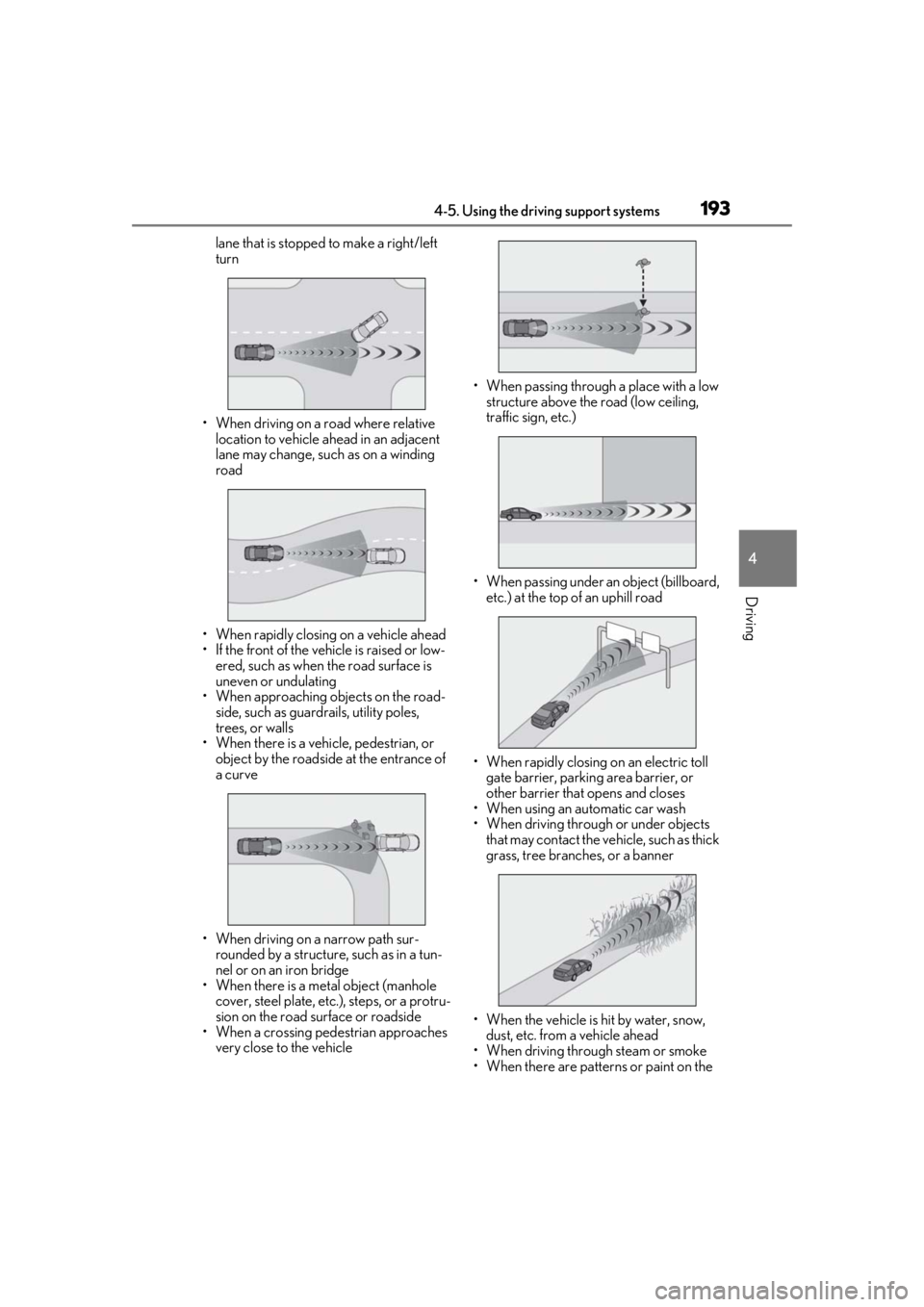
1934-5. Using the driving support systems
4
Driving
lane that is stopped to make a right/left
turn
ŌĆó When driving on a road where relative location to vehicle ahead in an adjacent
lane may change, such as on a winding
road
ŌĆó When rapidly closing on a vehicle ahead
ŌĆó If the front of the vehicle is raised or low- ered, such as when the road surface is
uneven or undulating
ŌĆó When approaching objects on the road- side, such as guardr ails, utility poles,
trees, or walls
ŌĆó When there is a vehicle, pedestrian, or object by the roadside at the entrance of
a curve
ŌĆó When driving on a narrow path sur- rounded by a structure, such as in a tun-
nel or on an iron bridge
ŌĆó When there is a metal object (manhole cover, steel plate, etc.), steps, or a protru-
sion on the road surface or roadside
ŌĆó When a crossing pedestrian approaches very close to the vehicle ŌĆó When passing through a place with a low
structure above the road (low ceiling,
traffic sign, etc.)
ŌĆó When passing under an object (billboard,
etc.) at the top of an uphill road
ŌĆó When rapidly closing on an electric toll gate barrier, parking area barrier, or
other barrier that opens and closes
ŌĆó When using an automatic car wash
ŌĆó When driving through or under objects that may contact the vehicle, such as thick
grass, tree branches, or a banner
ŌĆó When the vehicle is hit by water, snow, dust, etc. from a vehicle ahead
ŌĆó When driving through steam or smoke
ŌĆó When there are patterns or paint on the
Page 194 of 432
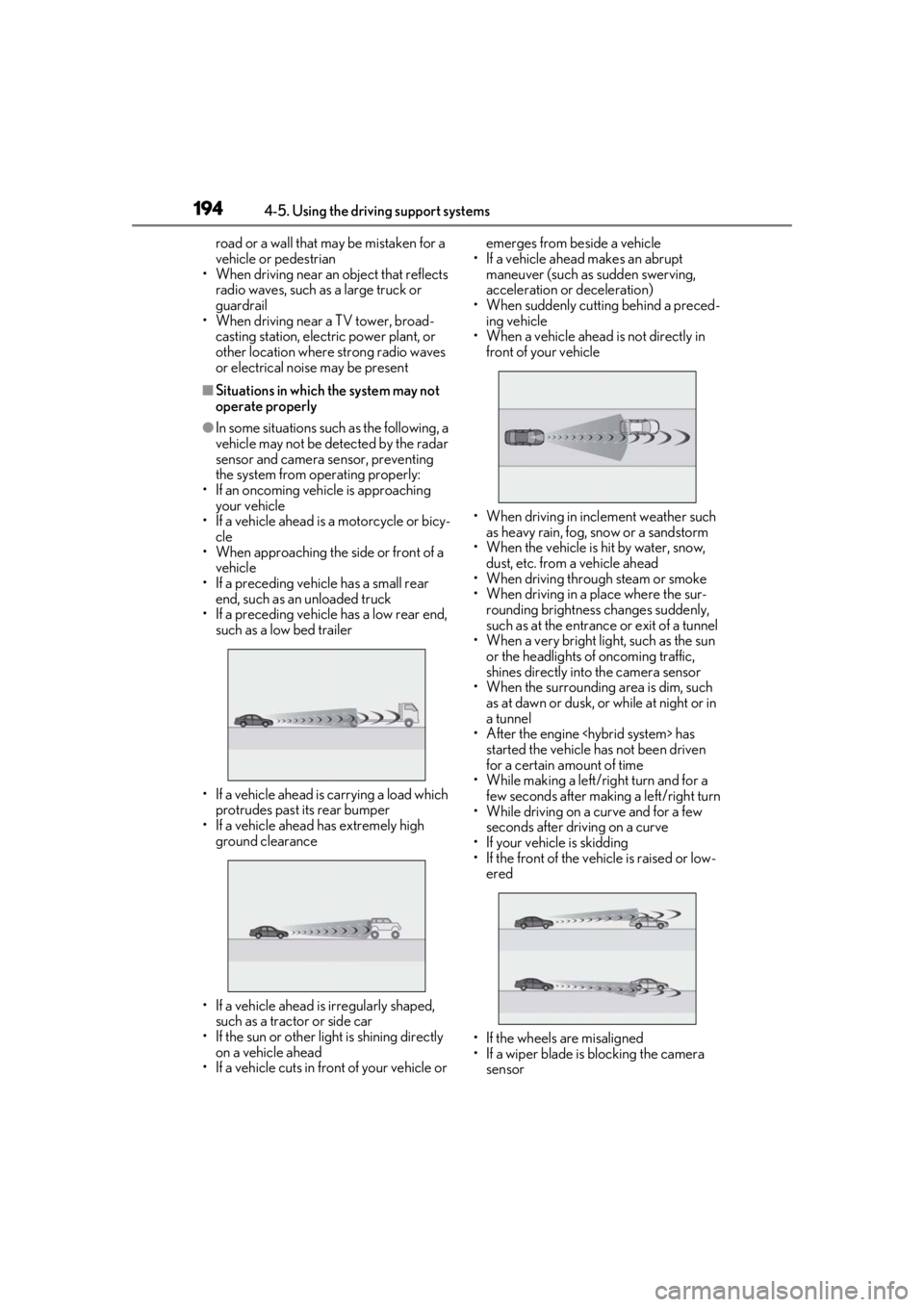
1944-5. Using the driving support systems
road or a wall that may be mistaken for a
vehicle or pedestrian
ŌĆó When driving near an object that reflects
radio waves, such as a large truck or
guardrail
ŌĆó When driving near a TV tower, broad-
casting station, electric power plant, or
other location where strong radio waves
or electrical noise may be present
Ō¢ĀSituations in which the system may not
operate properly
ŌŚÅIn some situations such as the following, a
vehicle may not be detected by the radar
sensor and camera sensor, preventing
the system from operating properly:
ŌĆó If an oncoming vehicle is approaching your vehicle
ŌĆó If a vehicle ahead is a motorcycle or bicy-
cle
ŌĆó When approaching the side or front of a vehicle
ŌĆó If a preceding vehicle has a small rear end, such as an unloaded truck
ŌĆó If a preceding vehicle has a low rear end,
such as a low bed trailer
ŌĆó If a vehicle ahead is carrying a load which protrudes past its rear bumper
ŌĆó If a vehicle ahead has extremely high ground clearance
ŌĆó If a vehicle ahead is irregularly shaped, such as a tractor or side car
ŌĆó If the sun or other light is shining directly
on a vehicle ahead
ŌĆó If a vehicle cuts in front of your vehicle or emerges from beside a vehicle
ŌĆó If a vehicle ahead makes an abrupt maneuver (such as sudden swerving,
acceleration or deceleration)
ŌĆó When suddenly cutting behind a preced- ing vehicle
ŌĆó When a vehicle ahead is not directly in front of your vehicle
ŌĆó When driving in incl ement weather such
as heavy rain, fog, snow or a sandstorm
ŌĆó When the vehicle is hit by water, snow,
dust, etc. from a vehicle ahead
ŌĆó When driving through steam or smoke
ŌĆó When driving in a place where the sur- rounding brightness changes suddenly,
such as at the entrance or exit of a tunnel
ŌĆó When a very bright light, such as the sun
or the headlights of oncoming traffic,
shines directly into the camera sensor
ŌĆó When the surrounding area is dim, such
as at dawn or dusk, or while at night or in
a tunnel
ŌĆó After the engine
started the vehicle has not been driven
for a certain amount of time
ŌĆó While making a left/r ight turn and for a
few seconds after making a left/right turn
ŌĆó While driving on a curve and for a few seconds after driving on a curve
ŌĆó If your vehicle is skidding
ŌĆó If the front of the vehicle is raised or low- ered
ŌĆó If the wheels are misaligned
ŌĆó If a wiper blade is blocking the camera sensor
Page 195 of 432
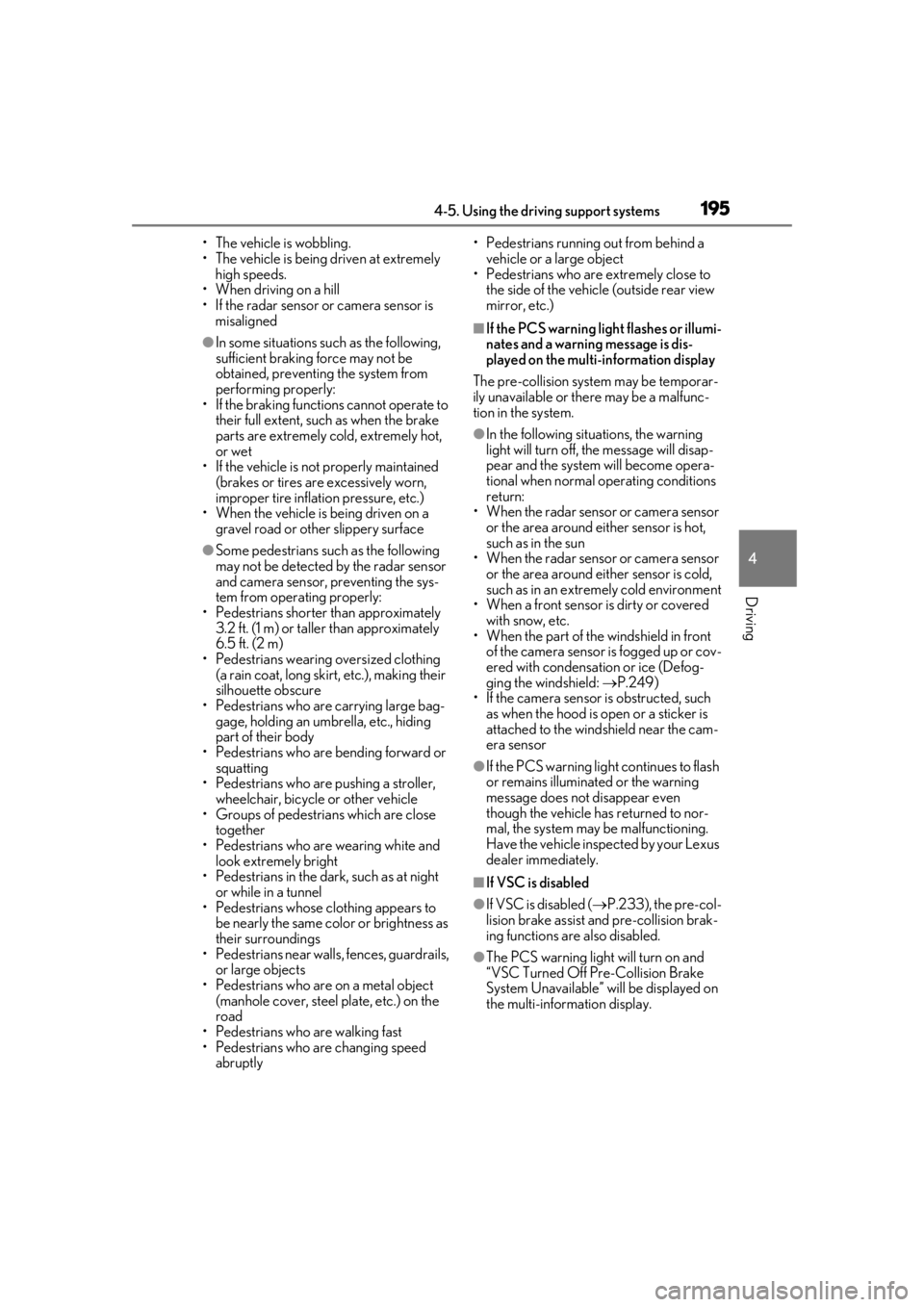
1954-5. Using the driving support systems
4
Driving
ŌĆó The vehicle is wobbling.
ŌĆó The vehicle is being driven at extremely high speeds.
ŌĆó When driving on a hill
ŌĆó If the radar sensor or camera sensor is misaligned
ŌŚÅIn some situations such as the following,
sufficient braking force may not be
obtained, preventing the system from
performing properly:
ŌĆó If the braking functions cannot operate to
their full extent, such as when the brake
parts are extremely cold, extremely hot,
or wet
ŌĆó If the vehicle is not properly maintained (brakes or tires are excessively worn,
improper tire inflation pressure, etc.)
ŌĆó When the vehicle is being driven on a gravel road or other slippery surface
ŌŚÅSome pedestrians such as the following
may not be detected by the radar sensor
and camera sensor, preventing the sys-
tem from operating properly:
ŌĆó Pedestrians shorter than approximately 3.2 ft. (1 m) or tall er than approximately
6.5 ft. (2 m)
ŌĆó Pedestrians wearing oversized clothing (a rain coat, long skirt, etc.), making their
silhouette obscure
ŌĆó Pedestrians who are carrying large bag- gage, holding an umbrella, etc., hiding
part of their body
ŌĆó Pedestrians who are bending forward or squatting
ŌĆó Pedestrians who are pushing a stroller, wheelchair, bicycle or other vehicle
ŌĆó Groups of pedestrians which are close
together
ŌĆó Pedestrians who are wearing white and look extremely bright
ŌĆó Pedestrians in the dark, such as at night or while in a tunnel
ŌĆó Pedestrians whose clothing appears to
be nearly the same co lor or brightness as
their surroundings
ŌĆó Pedestrians near walls , fences, guardrails,
or large objects
ŌĆó Pedestrians who are on a metal object (manhole cover, steel plate, etc.) on the
road
ŌĆó Pedestrians who are walking fast
ŌĆó Pedestrians who are changing speed abruptly ŌĆó Pedestrians running out from behind a
vehicle or a large object
ŌĆó Pedestrians who are extremely close to
the side of the vehicle (outside rear view
mirror, etc.)
Ō¢ĀIf the PCS warning light flashes or illumi-
nates and a warning message is dis-
played on the multi-information display
The pre-collision system may be temporar-
ily unavailable or there may be a malfunc-
tion in the system.
ŌŚÅIn the following situations, the warning
light will turn off, the message will disap-
pear and the system will become opera-
tional when normal operating conditions
return:
ŌĆó When the radar sensor or camera sensor
or the area around either sensor is hot,
such as in the sun
ŌĆó When the radar sensor or camera sensor
or the area around either sensor is cold,
such as in an extremely cold environment
ŌĆó When a front sensor is dirty or covered
with snow, etc.
ŌĆó When the part of the windshield in front of the camera sensor is fogged up or cov-
ered with condensation or ice (Defog-
ging the windshield: ’é«P.249)
ŌĆó If the camera sensor is obstructed, such
as when the hood is open or a sticker is
attached to the windshield near the cam-
era sensor
ŌŚÅIf the PCS warning light continues to flash
or remains illuminated or the warning
message does not disappear even
though the vehicle has returned to nor-
mal, the system may be malfunctioning.
Have the vehicle inspected by your Lexus
dealer immediately.
Ō¢ĀIf VSC is disabled
ŌŚÅIf VSC is disabled ( ’é«P.233), the pre-col-
lision brake assist and pre-collision brak-
ing functions are also disabled.
ŌŚÅThe PCS warning light will turn on and
ŌĆ£VSC Turned Off Pre-Collision Brake
System UnavailableŌĆØ will be displayed on
the multi-information display.
Page 196 of 432
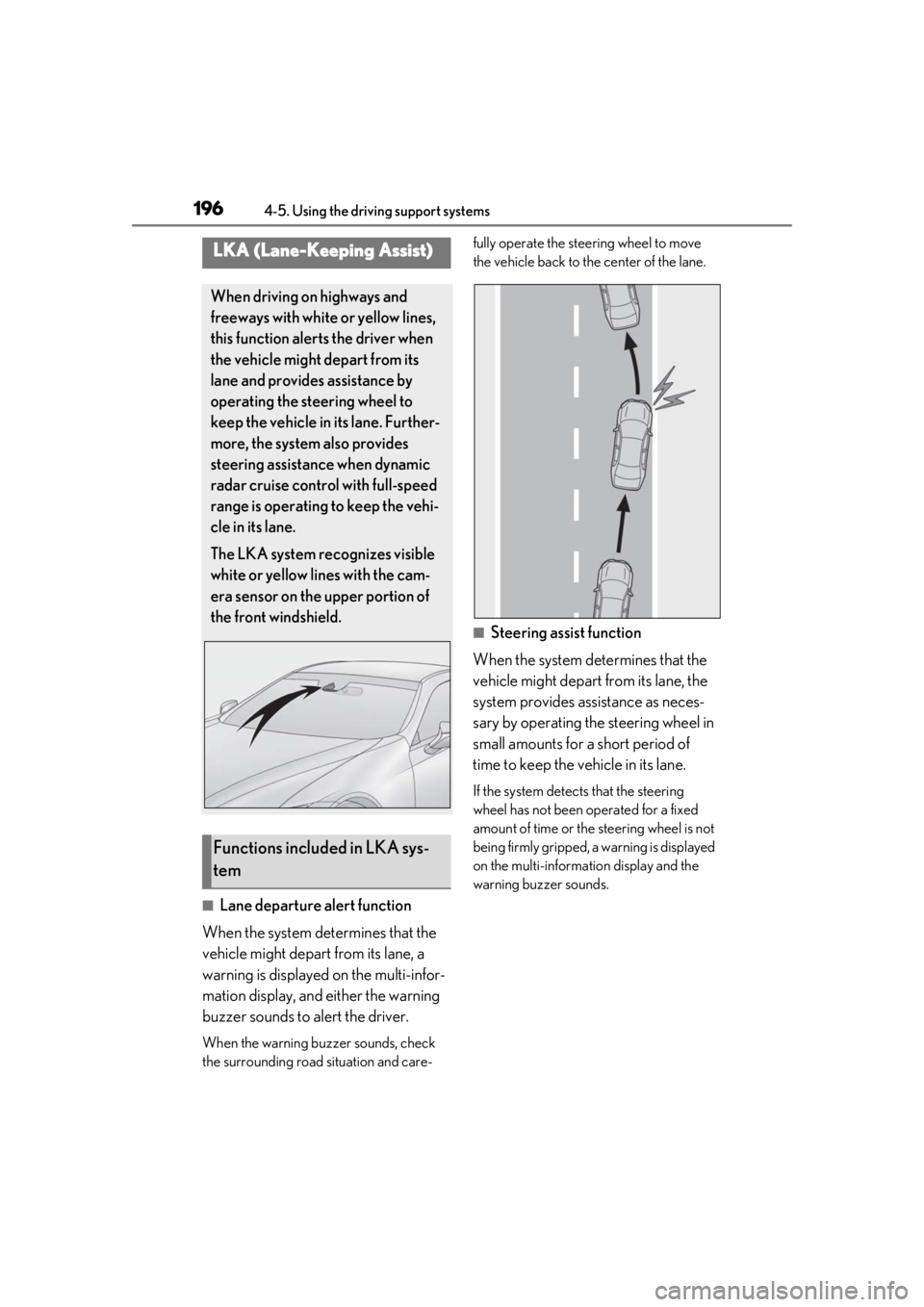
1964-5. Using the driving support systems
Ō¢ĀLane departure alert function
When the system determines that the
vehicle might depart from its lane, a
warning is displayed on the multi-infor-
mation display, and either the warning
buzzer sounds to alert the driver.
When the warning buzzer sounds, check
the surrounding road situation and care- fully operate the steering wheel to move
the vehicle back to the center of the lane.
Ō¢ĀSteering assist function
When the system determines that the
vehicle might depart from its lane, the
system provides assistance as neces-
sary by operating the steering wheel in
small amounts for a short period of
time to keep the vehicle in its lane.
If the system detects that the steering
wheel has not been operated for a fixed
amount of time or the steering wheel is not
being firmly gripped, a warning is displayed
on the multi-informat ion display and the
warning buzzer sounds.
LKA (Lane-Keeping Assist)
When driving on highways and
freeways with white or yellow lines,
this function alerts the driver when
the vehicle might depart from its
lane and provides assistance by
operating the steering wheel to
keep the vehicle in its lane. Further-
more, the system also provides
steering assistance when dynamic
radar cruise control with full-speed
range is operating to keep the vehi-
cle in its lane.
The LKA system recognizes visible
white or yellow lines with the cam-
era sensor on the upper portion of
the front windshield.
Functions included in LKA sys-
tem
Page 197 of 432
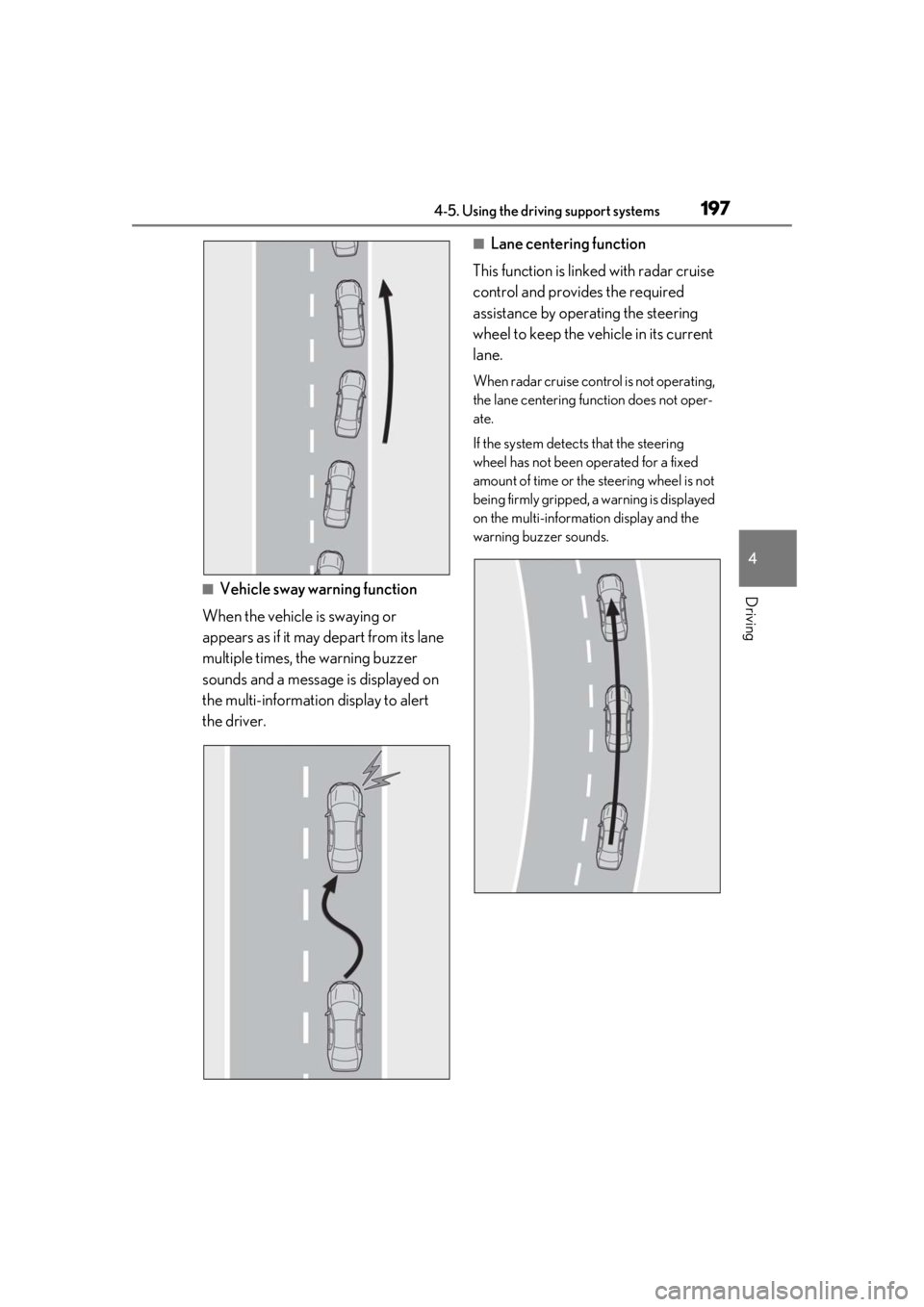
1974-5. Using the driving support systems
4
DrivingŌ¢ĀVehicle sway warning function
When the vehicle is swaying or
appears as if it may depart from its lane
multiple times, the warning buzzer
sounds and a message is displayed on
the multi-information display to alert
the driver.
Ō¢ĀLane centering function
This function is linked with radar cruise
control and provides the required
assistance by operating the steering
wheel to keep the vehicle in its current
lane.
When radar cruise cont rol is not operating,
the lane centering function does not oper-
ate.
If the system detects that the steering
wheel has not been operated for a fixed
amount of time or the steering wheel is not
being firmly gripped, a warning is displayed
on the multi-informat ion display and the
warning buzzer sounds.
Page 198 of 432
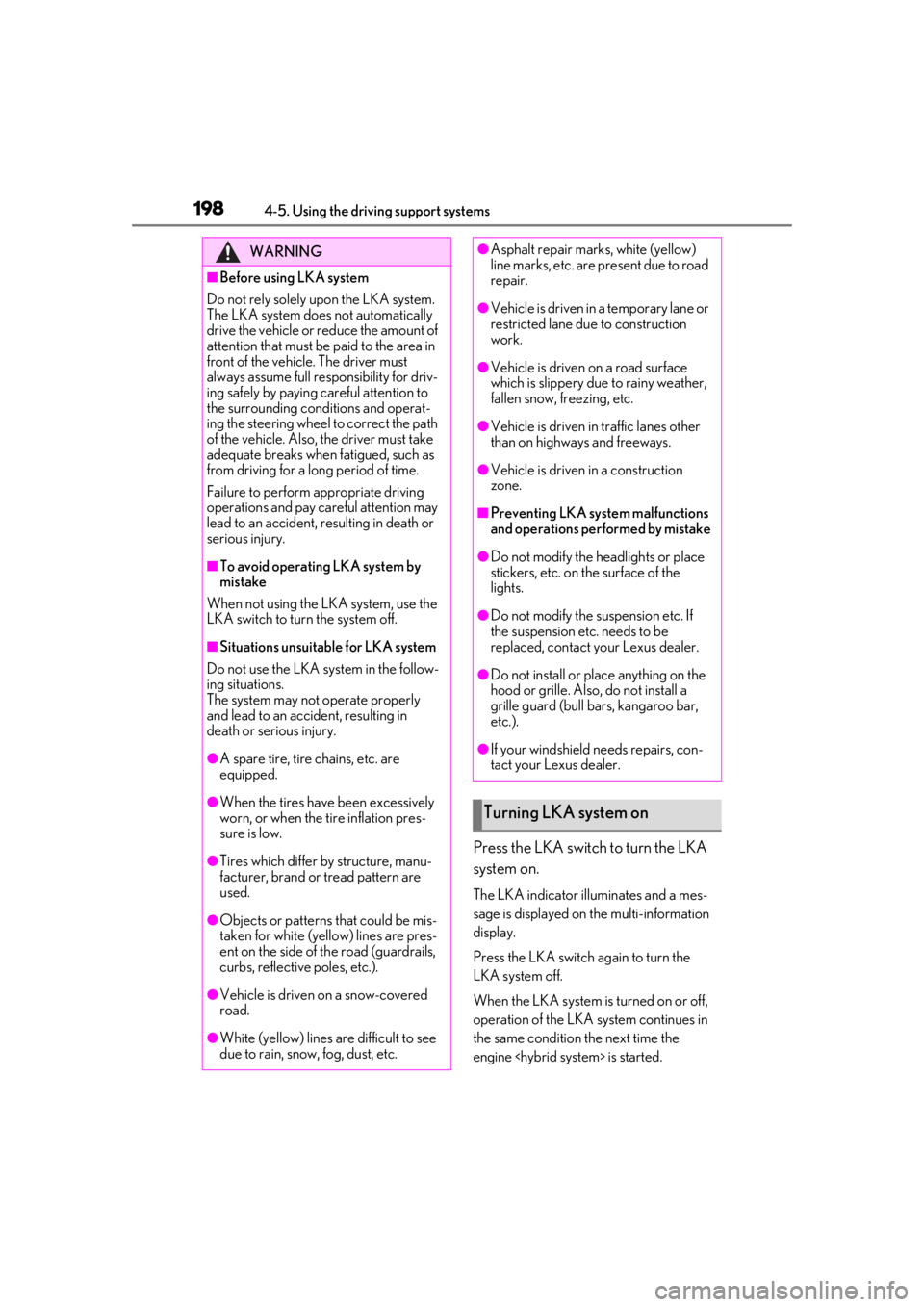
1984-5. Using the driving support systems
Press the LKA switch to turn the LKA
system on.
The LKA indicator illuminates and a mes-
sage is displayed on the multi-information
display.
Press the LKA switch again to turn the
LKA system off.
When the LKA system is turned on or off,
operation of the LKA system continues in
the same condition the next time the
engine
WARNING
Ō¢ĀBefore using LKA system
Do not rely solely upon the LKA system.
The LKA system does not automatically
drive the vehicle or reduce the amount of
attention that must be paid to the area in
front of the vehicle. The driver must
always assume full responsibility for driv-
ing safely by paying careful attention to
the surrounding conditions and operat-
ing the steering wheel to correct the path
of the vehicle. Also, the driver must take
adequate breaks when fatigued, such as
from driving for a long period of time.
Failure to perform appropriate driving
operations and pay careful attention may
lead to an accident, resulting in death or
serious injury.
Ō¢ĀTo avoid operating LKA system by
mistake
When not using the LKA system, use the
LKA switch to turn the system off.
Ō¢ĀSituations unsuitable for LKA system
Do not use the LKA system in the follow-
ing situations.
The system may not operate properly
and lead to an accident, resulting in
death or serious injury.
ŌŚÅA spare tire, tire chains, etc. are
equipped.
ŌŚÅWhen the tires have been excessively
worn, or when the tire inflation pres-
sure is low.
ŌŚÅTires which differ by structure, manu-
facturer, brand or tread pattern are
used.
ŌŚÅObjects or patterns that could be mis-
taken for white (yellow) lines are pres-
ent on the side of th e road (guardrails,
curbs, reflective poles, etc.).
ŌŚÅVehicle is driven on a snow-covered
road.
ŌŚÅWhite (yellow) lines are difficult to see
due to rain, snow, fog, dust, etc.
ŌŚÅAsphalt repair marks, white (yellow)
line marks, etc. are present due to road
repair.
ŌŚÅVehicle is driven in a temporary lane or
restricted lane due to construction
work.
ŌŚÅVehicle is driven on a road surface
which is slippery due to rainy weather,
fallen snow, freezing, etc.
ŌŚÅVehicle is driven in traffic lanes other
than on highways and freeways.
ŌŚÅVehicle is driven in a construction
zone.
Ō¢ĀPreventing LKA system malfunctions
and operations performed by mistake
ŌŚÅDo not modify the headlights or place
stickers, etc. on the surface of the
lights.
ŌŚÅDo not modify the suspension etc. If
the suspension etc. needs to be
replaced, contact your Lexus dealer.
ŌŚÅDo not install or place anything on the
hood or grille. Also, do not install a
grille guard (bull bars, kangaroo bar,
etc.).
ŌŚÅIf your windshield needs repairs, con-
tact your Lexus dealer.
Turning LKA system on
Page 199 of 432
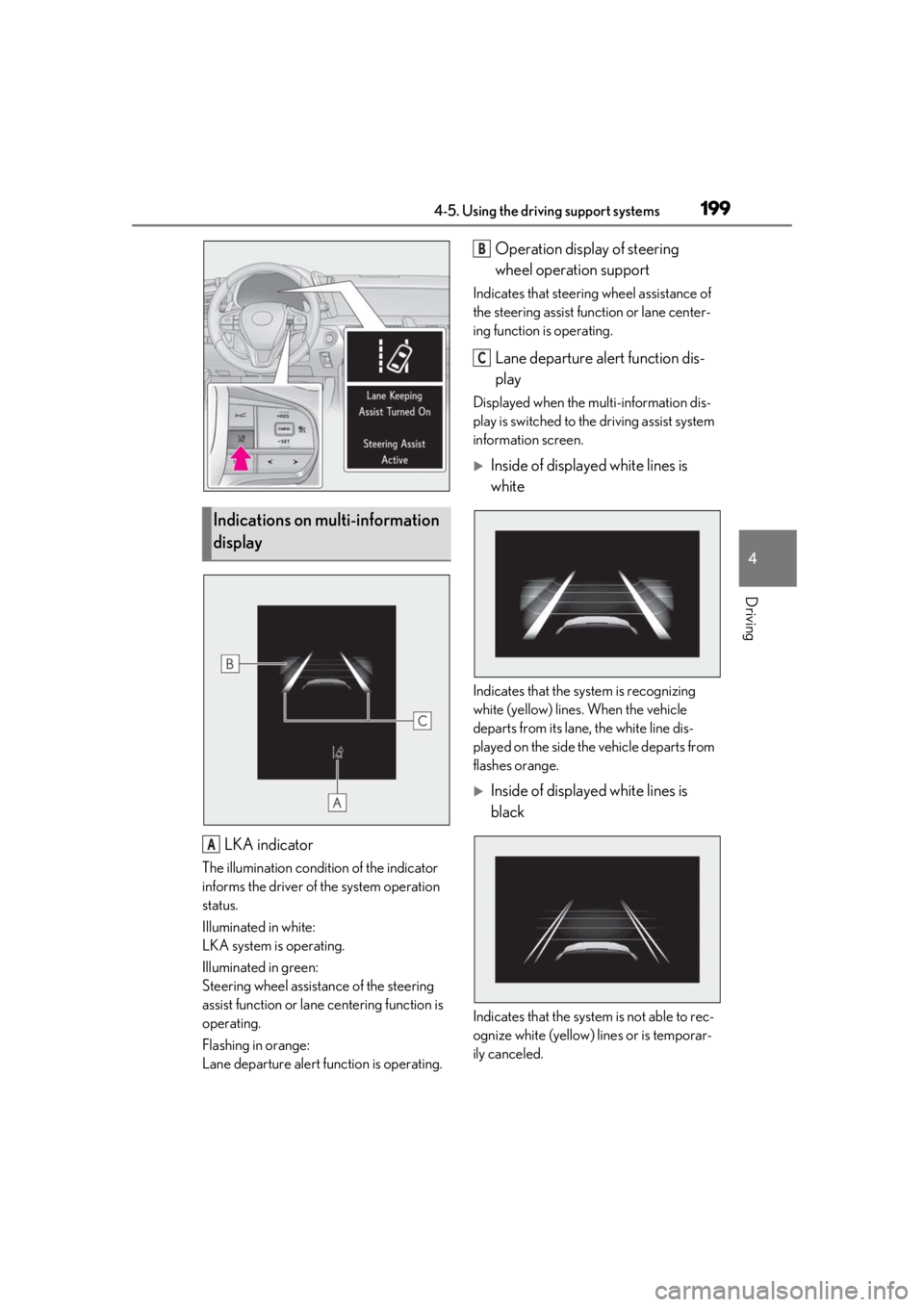
1994-5. Using the driving support systems
4
Driving
LKA indicator
The illumination condition of the indicator
informs the driver of the system operation
status.
Illuminated in white:
LKA system is operating.
Illuminated in green:
Steering wheel assistance of the steering
assist function or lane centering function is
operating.
Flashing in orange:
Lane departure alert function is operating.
Operation display of steering
wheel operation support
Indicates that steering wheel assistance of
the steering assist function or lane center-
ing function is operating.
Lane departure alert function dis-
play
Displayed when the multi-information dis-
play is switched to th e driving assist system
information screen.
’üĄInside of displayed white lines is
white
Indicates that the system is recognizing
white (yellow) lines . When the vehicle
departs from its lane , the white line dis-
played on the side the vehicle departs from
flashes orange.
’üĄInside of displayed white lines is
black
Indicates that the system is not able to rec-
ognize white (yellow) lines or is temporar-
ily canceled.
Indications on multi-information
display
A
B
C
Page 200 of 432
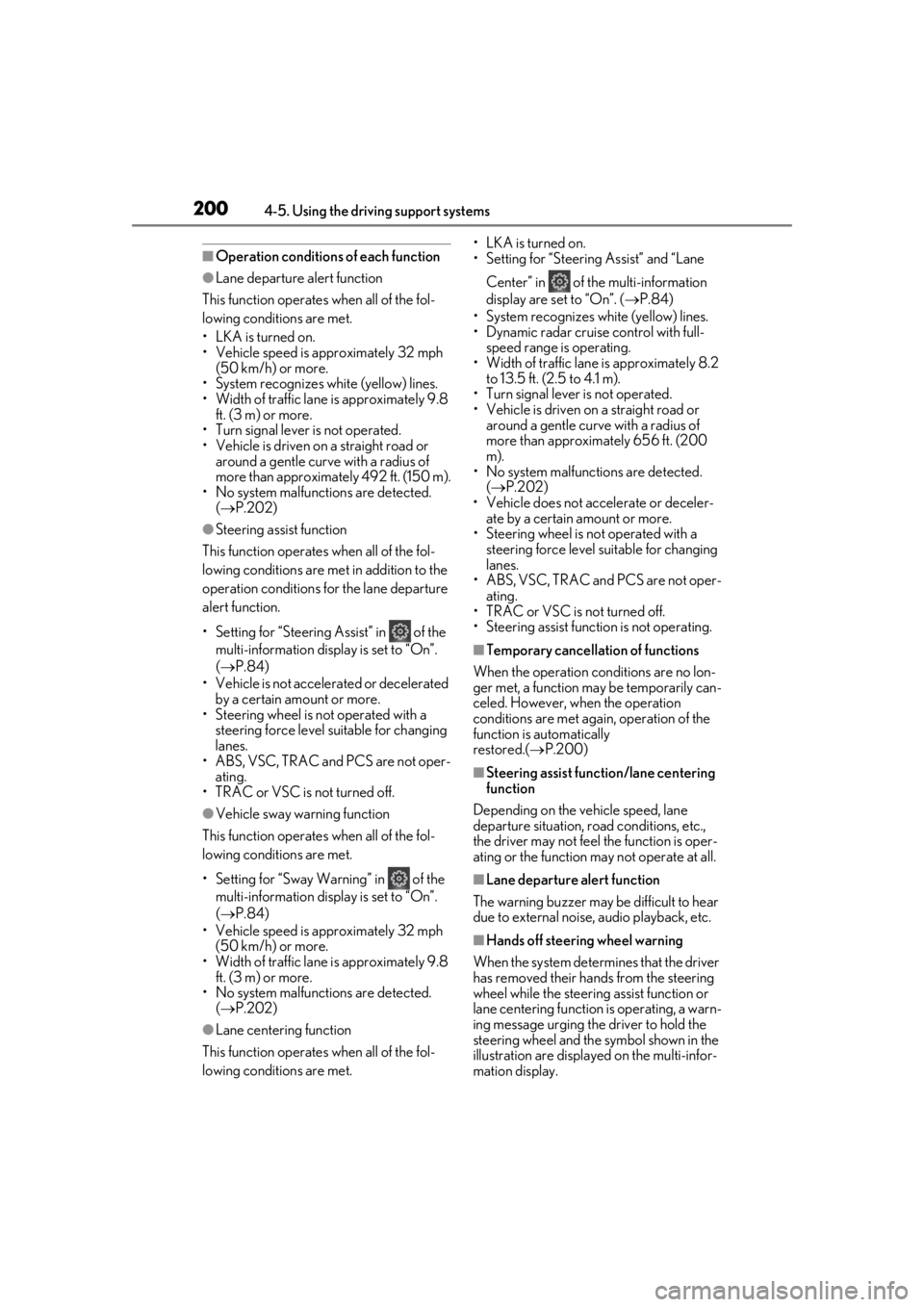
2004-5. Using the driving support systems
Ō¢ĀOperation conditions of each function
ŌŚÅLane departure alert function
This function operates when all of the fol-
lowing conditions are met.
ŌĆó LKA is turned on.
ŌĆó Vehicle speed is approximately 32 mph (50 km/h) or more.
ŌĆó System recognizes white (yellow) lines.
ŌĆó Width of traffic lane is approximately 9.8
ft. (3 m) or more.
ŌĆó Turn signal lever is not operated.
ŌĆó Vehicle is driven on a straight road or
around a gentle curve with a radius of
more than approximately 492 ft. (150 m).
ŌĆó No system malfunctions are detected. (’é« P.202)
ŌŚÅSteering assist function
This function operates when all of the fol-
lowing conditions are me t in addition to the
operation conditions for the lane departure
alert function.
ŌĆóSetting for ŌĆ£Steering AssistŌĆØ in of the multi-information display is set to ŌĆ£OnŌĆØ.
(’é« P.84)
ŌĆó Vehicle is not accelerated or decelerated by a certain amount or more.
ŌĆó Steering wheel is not operated with a
steering force level su itable for changing
lanes.
ŌĆó ABS, VSC, TRAC and PCS are not oper-
ating.
ŌĆó TRAC or VSC is not turned off.
ŌŚÅVehicle sway warning function
This function operates when all of the fol-
lowing conditions are met.
ŌĆó Setting for ŌĆ£Sway WarningŌĆØ in of the multi-information display is set to ŌĆ£OnŌĆØ.
(’é« P.84)
ŌĆó Vehicle speed is approximately 32 mph (50 km/h) or more.
ŌĆó Width of traffic lane is approximately 9.8
ft. (3 m) or more.
ŌĆó No system malfunctions are detected. (’é« P.202)
ŌŚÅLane centering function
This function operates when all of the fol-
lowing conditions are met. ŌĆó LKA is turned on.
ŌĆó Setting for ŌĆ£Steering AssistŌĆØ and ŌĆ£Lane
CenterŌĆØ in of the multi-information
display are set to ŌĆ£OnŌĆØ. ( ’é«P.84)
ŌĆó System recognizes white (yellow) lines.
ŌĆó Dynamic radar cruise control with full- speed range is operating.
ŌĆó Width of traffic lane is approximately 8.2 to 13.5 ft. (2.5 to 4.1 m).
ŌĆó Turn signal lever is not operated.
ŌĆó Vehicle is driven on a straight road or
around a gentle curve with a radius of
more than approximately 656 ft. (200
m).
ŌĆó No system malfunctions are detected. (’é« P.202)
ŌĆó Vehicle does not ac celerate or deceler-
ate by a certain amount or more.
ŌĆó Steering wheel is not operated with a steering force level su itable for changing
lanes.
ŌĆó ABS, VSC, TRAC and PCS are not oper- ating.
ŌĆó TRAC or VSC is not turned off.
ŌĆó Steering assist function is not operating.
Ō¢ĀTemporary cancellation of functions
When the operation conditions are no lon-
ger met, a function may be temporarily can-
celed. However, when the operation
conditions are met agai n, operation of the
function is automatically
restored.( ’é«P.200)
Ō¢ĀSteering assist function/lane centering
function
Depending on the vehicle speed, lane
departure situation, road conditions, etc.,
the driver may not feel the function is oper-
ating or the function may not operate at all.
Ō¢ĀLane departure alert function
The warning buzzer may be difficult to hear
due to external noise, audio playback, etc.
Ō¢ĀHands off steering wheel warning
When the system determines that the driver
has removed their hands from the steering
wheel while the steering assist function or
lane centering function is operating, a warn-
ing message urging the driver to hold the
steering wheel and the symbol shown in the
illustration are displayed on the multi-infor-
mation display.